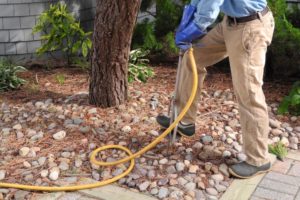 Wondering what deep root fertilization is and how it works. Want to learn how this process promotes healthy strong trees? Have you read conflicting view about the process ? Deep root fertilization for trees is a process where you stick a pipe down into the soil about 8-12″ and then, under pressure, squirt fertilizer into the ground. The theory is that since tree roots are deep down in the ground, the fertilizer would also need to be put deeper in the ground. Most qualified arborists agree that this is a highly beneficial investment for the health and longevity of your trees. A network of ISA-certified arborists are in favor of deep root fertilization.
Wondering what deep root fertilization is and how it works. Want to learn how this process promotes healthy strong trees? Have you read conflicting view about the process ? Deep root fertilization for trees is a process where you stick a pipe down into the soil about 8-12″ and then, under pressure, squirt fertilizer into the ground. The theory is that since tree roots are deep down in the ground, the fertilizer would also need to be put deeper in the ground. Most qualified arborists agree that this is a highly beneficial investment for the health and longevity of your trees. A network of ISA-certified arborists are in favor of deep root fertilization.
A Quick Guide to Deep Root Fertilization
The trees on your property look a lot like their self-sufficient, forest-dwelling cousins, but there’s one big difference: their environment. Wild trees don’t survive to maturity unless they’ve taken root in a place that meets all their needs. Compare that to trees on developed land, which are often transplanted, subjected to landscape changes, or forced to compete for nutrients with grass. If the trees and shrubs on your property weren’t carefully selected for the site, there’s a good chance they’re not getting all the nutrients they need. This makes for trees that grow slower, are more susceptible to insects and disease, and have shorter life spans—not exactly ideal for your yard. Whether it is because of transplantation, incompatibility to the native ares, or pollution even the established trees on your property are vulnerable to tree pest, diseases and nutrient deficiencies.
Deep Root Fertilization Basics
The process involves injection of liquid fertilizer into the root zone of trees and shrubs. Roots thrive in healthy soil that is nutrient balanced and rich in oxygen. This fertilization process addresses these aspects. The liquid fertilizer activates the microbial activity of the soil and increases its nutrient levels. The pressure controlled release aerates the soil which gives it the needed oxygen boost.
Why Should You Consider Deep Root Fertilization…
Have you had a soil analysis and it revealed a deficiency in nitrogen ( N) , phosphorus (P) or potassium (K) levels ? These are the nutrient that are essential to the healthy growth of your trees and shrubs. Do you see tree and shrub pests on your trees and shrubs? Have you noticed yellowing of the leaves? Is there a lack of new shoot growth? Deep root fertilization will help nourish them back to good health. Usually in a short period of time.
Steps Involved in Deep Root Fertilization…
- Digging The Holes – To deep feed the roots of a tree, we encircle it with narrow holes dug two feet to three feet apart. The holes are dug several feet away from the tree’s base. The holes are placed along the drip line of the tree. The soil removed from each hole is quickly replaced in the holes once the process of deep feeding the tree’s roots is completed.
- Adding A Slow-Release Fertilizer – A slow-release, liquid fertilizer is used during the deep fertilization process. This enhances the soil’s biology and chemistry and reduces the susceptibility of the tree to soil pollutants. A slow-release liquid so that the roots will gradually absorb a consistent amount of the nutrient-rich fertilizer over a long period of time. The fertilizer begins working right away to enrich the soil, nourish the roots and improve the health, strength and vitality of the trunk, limbs, and leaves as well.
- Administering The Liquid Fertilizer – Once the holes have been dug and the fertilizer prepared, the third step in the process is to slowly pour it into the holes. This is done so that it can permeate deep into the soil and enable its nutrients to make the entire area richer. Approximately one 1/2 gallon of the mixture is fed into each prepared hole. Once the filling process is complete and each hole has received it’s allotted amount of root food,then each of the holes are refilled with the soil which was removed from it.
The Ideal Time for Deep Root Fertilization
Most arborist recommend deep root fertilization once or twice a year, in the spring and/or fall. Springtime provides a nutrient boost for the growing season ahead and fall is ideal for the trees to store nutrient that help them through their winter dormancy. The process is not beneficial during the summer and winter months. And remember deep root fertilization may not be suitable for every tree, some with certain diseases or stressed trees or newly planted ones , your arbortist will be able to suggest which trees and shrubs you would like to have deep root fertilized. Only a tree service expert will have the equipment needed to preform deep root tree fertilization.
Is your property not receiving the attention it deserves? Are you tired of overpaying for subpar service? First Green Landscaping provides the best value for professional lawn care and landscaping services in the Cincinnati / Northern Kentucky area. No property is too big or too small for First Green Landscaping.
Contact us (859-292‐8556) today for a free consultation!
—
 About First Green Commercial Landscaping
About First Green Commercial Landscaping
First Green Commercial Landscaping is a locally owned leading provider of lawn care and landscaping services in the Cincinnati / Northern Kentucky area. We provide superior customer service and strive to build long term business relationships with our clients.
- Lawn Care
- Landscape Maintenance
- Snow Removal
>> Learn More
